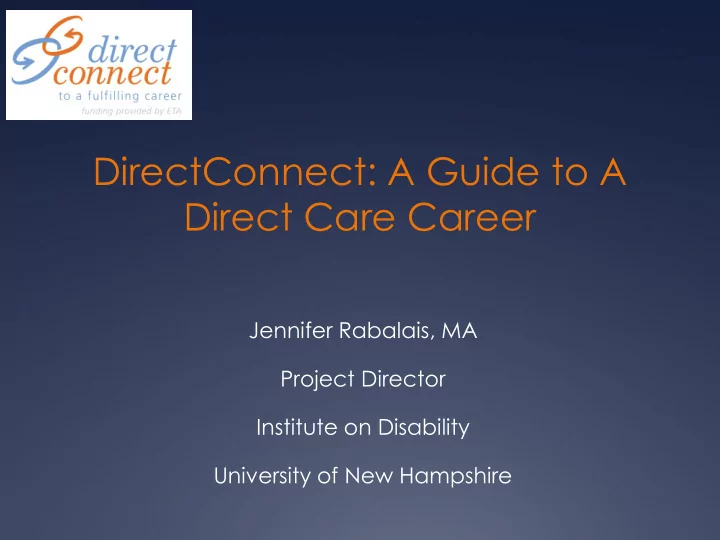

DirectConnect: A Guide to A Direct Care Career Jennifer Rabalais, MA Project Director Institute on Disability University of New Hampshire
DirectConnect 3 year, $2.9 million dollar grant funded by the • Department of Labor Addresses multiple issues in the direct care • workforce Including issues around current and projected • workforce shortages, training and retention DirectConnect presents a multi-prong approach • to these issues across all populations
Background NH Coalition for the Direct Care Workforce • Formed in 2007 • Identify workforce related issues • Propose solutions, shape policy • Broad base of stakeholders represented Carsey Institute In 2009 created a policy brief entitled “Home Care • Workers: Keeping Granite Staters in Their Home as They Age”
DirectConnect March 2010 DOL grant is awarded • UNH Institute on Disability • Grant focus: 3 main areas. Workforce recruitment Training and education Retention of workers in home and community based settings
Recruitment • Comprehensive career awareness campaign that focuses on the value of the work and highlights the benefits of many direct care positions. • Direct care workers: can make a significant difference in the lives of others. Work is meaningful and can be very fulfilling. • Outreach campaign includes use of a dedicated website, posters, brochures, public service announcements, and print advertisements. • Development of a cross sector career lattice
Training and Education • Paraprofessional Healthcare Institute (PHI) • The College of Direct Support • NH Community College System • Lutheran Social Services Refugee Resettlement Program • Connect NH formerly Granite State Distance Learning Network (GSDLN)
Training and Education Granite State Distance Learning Network (GSDLN) UNH non-profit bringing affordable distance learning • technologies to all areas of New Hampshire Used as part of the College of Direct Support • implementation allowing for facilitated discussion among staff throughout New Hampshire Other trainings will be made available using this • technology
Retention • Examination of best practices related to increased retention of workers and creation of 2-3 briefs that will be included as part of a tool kit for employers. • PHI training offered through the grant. • Development of a Direct Care Career Lattice
Career Lattice • Designed to be a graphic representation of potential career paths within the direct care workforce. • “Up is not the only way” • Career lattice will be used for addressing retention, awareness/recruitment campaign, skills standards collaboration.
Industry Career Lattices Industry Career Lattices: attract individuals to an industry by showing • potential career progression beyond entry points focus workforce development efforts • show workers how different jobs interconnect • within careers in an industry inform workers about the training, education, • and developmental experiences that would enable them to accomplish their career objectives.
A Guide to a Direct Care Career
Interactive web version http://client.millennium-im.com/direct_connect/careerguide_002.html
How we are using the Career Lattice Recruitment - • attract individuals to the direct care industry by showing potential career progression beyond entry points Change public perception of direct care positions as “dead end jobs” Retention - • Keep workers in the industry rather than leave for another industry Encourage development of organizational career lattices
Why create an Organizational career lattice? Challenging times create opportunity to • build employee commitment and loyalty Pro-active planning leads to better decision • making Demonstrates commitment to employees • Not costly to create a career lattice • Turnover IS costly •
Why employees leave
Linking career lattices to retention • Employees don’t need to look elsewhere for career development opportunities • Attention to employees needs/interests builds loyalty and commitment
How to create an Organizational Career Lattice • Organize a team or committee to develop the career lattice • List jobs within your organization • Decide on format or layout for graphic view
Creating a career lattice • Create a visual/graphic representation that portrays your structure showing each job and possible paths to and from it.
Creating a career lattice Include tasks and responsibilities of the • position. Include educational and experience requirements Create competencies and critical • development include knowledge, skills and abilities Review with non members of work group • Identify and address system and cultural • barriers Communicate, distribute, disseminate! •
Supporting a Career Lattice Organizational culture needs to support the • career lattice Attract and hire people with the potential to grow who also share the organization's values Train and nurture them Promote them Keep their skills up to date Honor, recognize and reward them regularly and consistently Maintain a culture of community, teamwork, mutual respect and lifelong learning.
Resources for building career lattices Career One Stop: Competency Model Clearinghouse http://www.careeronestop.org/CompetencyModel/ O*Net: tool to design ladders/lattices http://www.onetcenter.org/ladders.htm.
Summary The DirectConnect project team is available to discuss your specific needs and help you determine how to best leverage this exciting resource. Contact information: https://directconnectnh.org careers@directconnectnh.org 1-855-MyNewCareer (855-696-3922). THANK YOU!
Questions
Recommend
More recommend